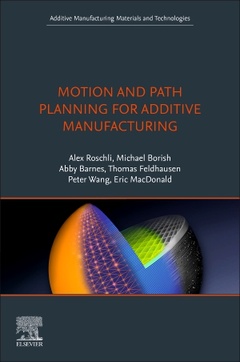Motion and Path Planning for Additive Manufacturing Additive Manufacturing Materials and Technologies Series
Auteurs : Roschli Alex C., Borish Michael C., Barnes Abby K., Feldhausen Thomas A., Wang Peter, MacDonald Eric

Motion and Path Planning for Additive Manufacturing takes a deep dive into the concepts and computations behind slicing software ? the software that uses 3D models to generate the commands required to control the motion of a 3D printer and ultimately construct objects.
Starting with a brief review of the different types of motion in additive systems, this book walks through the steps of the path planning process and discusses the different types of toolpaths and their corresponding function in additive manufacturing. Planar, non-planar, and off-axis path planning are examined and explained. This book also presents pathing considerations for different types of 3D-printers, including extrusion, non-extrusion, and hybrid systems as well as 3- and 5-axis systems.
Engineers, researchers, and designers in the additive manufacturing field can use this book as a reference for every step of the path planning process, as well as a guide that explains the computations underlying the creation and use of toolpaths.
1. Introduction to AM 2. Kinematics of Motion 3. Motion Platforms 4. Geometry Data Storage 5. Cross-sectioning 6. Closed-Loop Toolpath Generation 7. Space Filling Toolpath Generation 8. Open-Loop Toolpath Generation 9. Support, Raft, Brim, and Skirt Pathing 10. Path Modifiers 11. Travels, Optimizations, and Ordering 12. Pathing Considerations for Extrusion: Pellet, Filament, Concrete and Thermoset 13. Pathing Considerations for DED: Arc Welding and Laser Welding 14. Planar Slicing for Non-Extrusion AM Processes 15. Nonplanar Slicing 16. Pathing Considerations for 5-Axis Planar AM 17. Pathing Considerations for Hybrid AM 18. The G-Code File 19. Closing The Loop
His current focus is software development for toolpath generation in additive manufacturing. This includes slicing, printing, motor and extrusion control, and closed loop data feedback. Alex manages development of ORNL Slicer 2, a novel toolpath generation software produced at ORNL.
Dr. Michael Borish is a research staff member in the Manufacturing Demonstration Facility (MDF) at Oak Ridge National Laboratory (ORNL), having joined in 2017. At the MDF, he engages in a wide range of disciplines within Computer Science as they relate to industrial additive manufacturing. This research encompasses visualization, augmented reality, path planning, and computer vision, to name a few. He hopes to expand the boundaries of what we define as manufacturing technology. He is also interested in altering established paradigms of operation particularly as it relates to slicing and path planning and has been developing custom slicing software to that end. He has also built an open-source community around slicing software to advance the state of the art in path planning for industrial additive manufacturing.
Abby Barnes is a Research Communications Professional at Oak Ridge National Laboratory's Manufacturing Demonstration Facility. She was previously a researcher in at the University of Tennessee, Knoxville. She has co
- Outlines the entire toolpath planning process required to go from a computer-aided design (CAD) model to G-code that a 3D printer can then use to construct a part
- Defines the terms and variables used in slicing and other path-planning software
- Highlights all the available kinematic arrangements for motion systems in additive manufacturing as well as the advantages and risks of each method
- Discusses the nuances of path planning for extrusion, non-extrusion, and hybrid process as well as 3- and 5-axis additive systems
- Provides an up-to-date explanation of advancements in toolpath planning and state-of-the-art slicing processes that use real-time data collection
Date de parution : 11-2023
Ouvrage de 296 p.
15.2x22.8 cm


